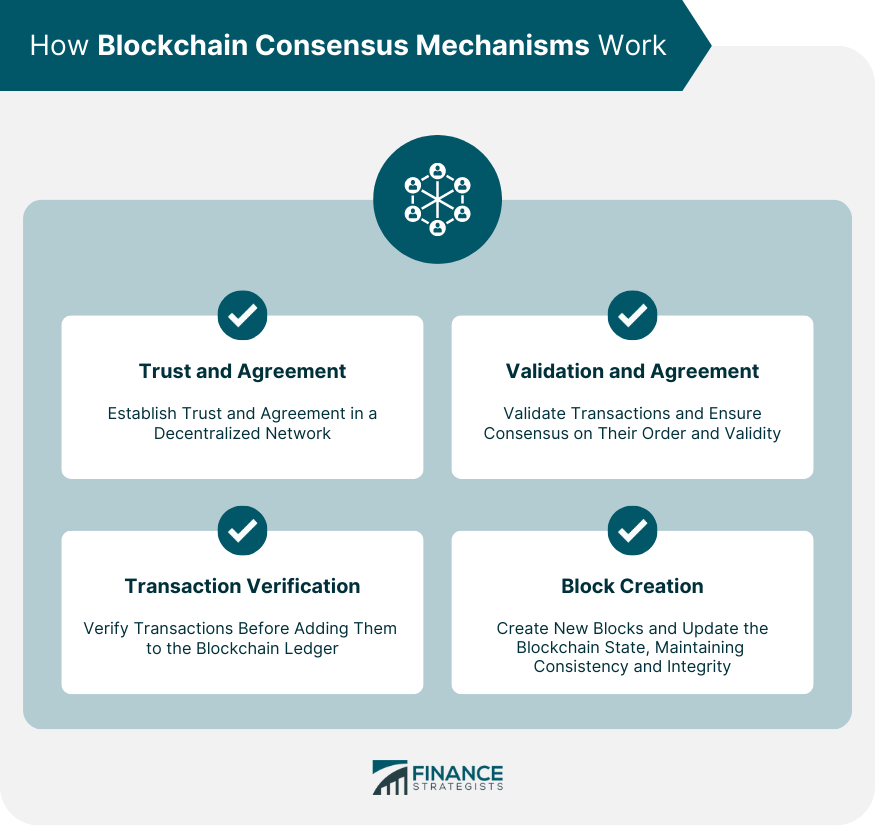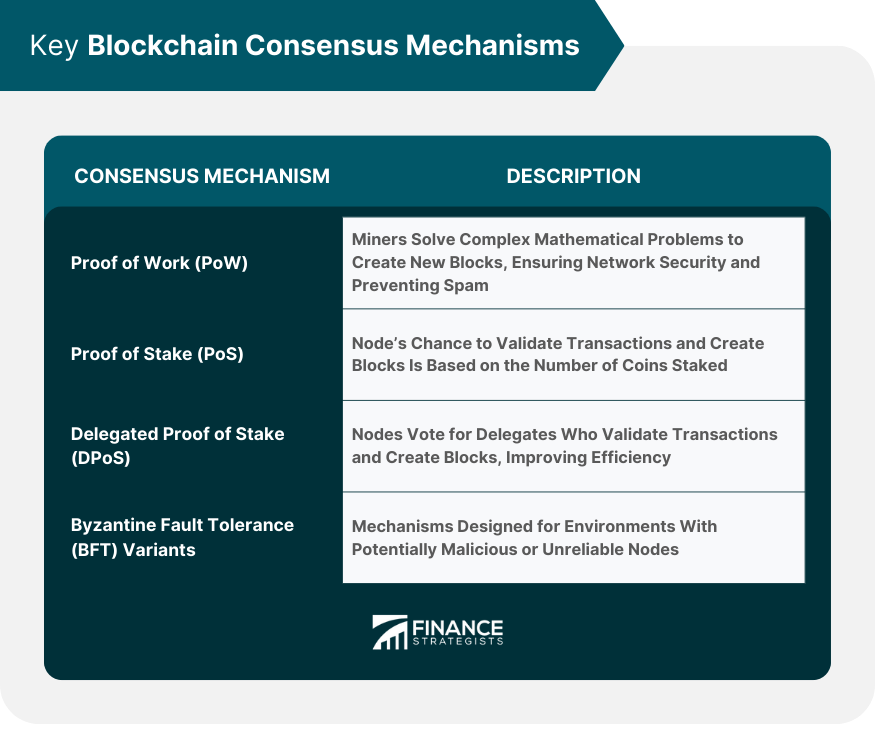Blockchain Consensus Mechanisms are the protocols that blockchain networks use to achieve agreement or consensus among distributed nodes. They validate and verify the transactions to be added to the blockchain, ensuring that all copies of the distributed ledger share the same state. Consensus mechanisms play a pivotal role in the functioning and security of a blockchain network. They ensure that only valid transactions are added to the blockchain, prevent double-spending, and protect the network from various types of attacks. Furthermore, they foster a trustless environment, where no single entity has authority, and each participant follows the rules set by the consensus algorithm. Blockchain consensus mechanisms aim to create trust in a decentralized network environment. They help nodes agree on the current state of the blockchain, ensuring that all nodes concur about the order and validity of transactions. When a new transaction occurs on the blockchain, it needs to be validated before it's added to the blockchain ledger. The specific process of validation depends on the consensus mechanism employed by the blockchain. Once transactions are validated, the consensus mechanism plays a role in creating new blocks. The block is added to the chain, and the updated blockchain state is propagated across the network. In this way, consensus mechanisms maintain the consistency and integrity of the blockchain. Proof of Work (PoW) is the original consensus algorithm used in Bitcoin. It requires nodes, known as miners, to solve a complex mathematical problem to create a new block. The difficulty of this problem ensures that it takes significant computational resources, thereby preventing spam or attacks on the network. Proof of Stake (PoS) is an alternative to PoW that's designed to be more energy-efficient. Instead of using computational power, PoS relies on the number of coins a node holds and is willing to 'stake' as a measure of its chance to validate transactions and create new blocks. Delegated Proof of Stake (DPoS) is a variant of PoS where nodes vote for a small number of 'delegates' who then validate transactions and create new blocks. This model aims to be more efficient than traditional PoS. BFT-based mechanisms, like the Practical Byzantine Fault Tolerance (PBFT), are designed to work in environments where nodes may act maliciously or become unreliable. They ensure the network continues to operate correctly as long as a certain percentage of nodes are trustworthy. Consensus mechanisms is integral in verifying the authenticity of transactions. They ensure that only valid transactions, i.e., those digitally signed by the sender, are added to the blockchain. Double spending, where a user attempts to spend the same digital asset more than once, is a significant risk in digital currencies. Consensus mechanisms help prevent this by verifying that the sender has enough balance for the transaction and has not already spent it. Consensus mechanisms are also critical in securing the blockchain from various types of attacks. For instance, PoW's computational requirements make it economically unviable for an attacker to gain control of the majority of the network, a scenario known as a 51% attack. One of the significant criticisms of PoW-based blockchains like Bitcoin is the high energy consumption, leading to a large environmental footprint. It has led to the exploration of alternative, more energy-efficient consensus mechanisms. Achieving consensus in a decentralized network can be time-consuming and limit the blockchain's transaction speed and scalability. This issue is particularly pronounced in PoW-based blockchains. Some consensus mechanisms, especially PoS, and its variants, can potentially lead to centralization. Wealthy nodes or delegates may gain disproportionate control over the network, opposing the decentralization principle fundamental to the blockchain. The choice of consensus mechanism is critical as it needs to align with the network's goals. For instance, a network focusing on speed and energy efficiency might choose PoS, while a network prioritizing maximum security may opt for PoW. The consensus mechanism must strike a balance between efficiency, security, and decentralization. It is often a trade-off, and the selected mechanism should reflect the network's priorities. Blockchain technology is rapidly evolving, and the chosen consensus mechanism should be adaptable to future changes and needs. It might involve the ability to switch to a different mechanism if required or have built-in flexibility to adjust parameters as per network needs. Blockchain Consensus Mechanisms play a fundamental role in blockchain networks, creating a trustless, decentralized environment where transactions are verified, validated, and recorded on the ledger. Consensus mechanisms, such as Proof of Work, Proof of Stake, and their variants, each have their unique strengths and challenges, which influence a network's efficiency, security, and level of decentralization. These mechanisms are responsible for preventing double-spending, ensuring transaction authenticity, and protecting the network from various potential attacks. However, they also grapple with issues of high energy consumption, scalability limitations, and the risk of centralization. In the fast-evolving world of blockchain technology, selecting a consensus mechanism that aligns with a network's goals while offering future adaptability is a critical decision that can shape the network's functionality and success.What Are Blockchain Consensus Mechanisms?
How Blockchain Consensus Mechanisms Work
Fundamental Principle: Trust and Agreement
Validation and Agreement
Role in Transaction Verification and Block Creation

Understanding Key Blockchain Consensus Mechanisms
Proof of Work (PoW)
Proof of Stake (PoS)
Delegated Proof of Stake (DPoS)
Byzantine Fault Tolerance (BFT) Variants

Role of Blockchain Consensus Mechanisms in Network Security
Ensure Transaction Authenticity
Prevent Double Spending
Mitigate Attacks
Challenges and Limitations of Blockchain Consensus Mechanisms
High Energy Consumption and Environmental Impact
Issues With Scalability and Efficiency
Risk of Centralization in Some Mechanisms
Importance of Selecting the Right Consensus Mechanism
Matching Network Needs and Goals
Balancing Efficiency, Security, and Decentralization
Considerations for Future Adaptability
Conclusion
Blockchain Consensus Mechanisms FAQs
A Blockchain Consensus Mechanism is a protocol used in blockchain networks to achieve agreement or consensus among distributed nodes. It validates and verifies transactions to be added to the blockchain, ensuring all copies of the distributed ledger share the same state.
Consensus mechanisms are crucial for the functioning and security of a blockchain network. They ensure only valid transactions are added to the blockchain, prevent double-spending, and protect the network from attacks. They also foster a trustless environment where no single entity has authority.
Examples include Proof of Work (PoW), used in Bitcoin, which requires significant computational resources to validate transactions. Another is Proof of Stake (PoS), which is more energy-efficient and depends on the number of coins a node holds. Variants like Delegated Proof of Stake (DPoS) and Byzantine Fault Tolerance (BFT) models also exist.
Challenges include high energy consumption (especially with PoW), scalability and efficiency issues, and the risk of centralization, where wealthy nodes gain disproportionate control over the network, particularly in PoS and its variants.
The choice should align with the network's goals and needs. It involves balancing efficiency, security, and decentralization. The mechanism should also be adaptable to future changes and needs in the rapidly evolving landscape of blockchain technology.
True Tamplin is a published author, public speaker, CEO of UpDigital, and founder of Finance Strategists.
True is a Certified Educator in Personal Finance (CEPF®), author of The Handy Financial Ratios Guide, a member of the Society for Advancing Business Editing and Writing, contributes to his financial education site, Finance Strategists, and has spoken to various financial communities such as the CFA Institute, as well as university students like his Alma mater, Biola University, where he received a bachelor of science in business and data analytics.
To learn more about True, visit his personal website or view his author profiles on Amazon, Nasdaq and Forbes.











